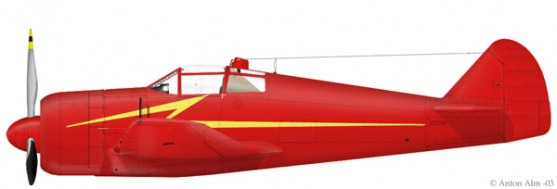Artwork by Anton Alm
Text by Magnus Fridsell and Martin Waligorski
The FFVS J 22 was a fighter aircraft developed in Sweden as a stop-gap measure during World War II. Very little known internationally, it was an important episode in the development of the Swedish aircraft industry and as such has been previously covered at the IPMS Stockholm’s site (see FFVS J 22 in Detail). Due to contribution by the Swedish modeller and profile artist Anton Alm we can now also present a set well-researched colour profiles.
At the onset of World War II, the Swedish Air Force fighter arm was equipped with largely obsolete Gloster Gladiators (J 8). To remedy the situation, Sweden ordered Seversky P-35 (J 9) and Vultee P-66 Vanguard (J 10) aircraft from the United States. Soon, the war raged throughout Europe, the United States imposed an embargo on exporting weapons, and Sweden, itself under overwhelming threat of German invasion, was cut off from most military supplies and in desperate need of modern combat aircraft.
Several foreign alternatives were considered but Finnish VL Myrsky and Soviet Polikarpov I-16 were deemed unsatisfactory, and Japanese A6M Zero impossible to ship to Europe. A batch of Fiat CR.42 Falco (J 11) biplanes and Reggiane Re.2000 Falco (J 20) were eventually purchased from Italy but this was clearly only a stop-gap solution. More aircraft were needed.
With Saab running at full capacity building Saab 17 and Saab 18 bombers (and using up all available light alloys in the process), a new firm and factory were established specifically for building a domestic fighter aircraft – Kungliga Flygförvaltningens Flygverkstad (FFVS), situated at the Bromma airfield in Stockholm . Design work started in 1941 lead by Bo Lundberg who was previously overseeing the procurement of the embargoed Vultee Vanguard.
The resulting aircraft, designated J 22, was a monoplane with a welded-steel construction and plywood skin. Wing and fuselage layout were conventional, with the narrow-track main landing gear retracting rearward into the fuselage. One of the biggest design challenges was imposed by the powerplant. The only modern engine available in Sweden at a time was a Pratt and Whitney R-1830 SC3-G, rated at 1050 hp. These engines were the same as used for the French Curtiss H.75 Hawks, and were indeed purchased from Germany’s war booty, later also copied and produced in Sweden under the designation STWC-3G. The available power was marginal for a fighter design, but there were simply no other choices. Much emphasis was therefore laid on the the aerodynamic efficiency of the airframe, resulting in a sleek and elegant looking aircraft.
The J 22 first flew on 20 September 1942. It entered service in October 1943, with the last of the 198 aircraft delivered in April 1946.
The aircraft fulfilled the expectations. In level flight it could reach a top speed of 560 km/h (348 mph) at 4300 m (14000 ft). Not bad at all given a 1000-horsepower engine, and actually faster than both the Spitfire Mk I and the Messerschmitt 109E-4 which had about the same engine power. The problem was, of course, that by 1943-1944 this performance was not sufficient to match the newest fighters of combating nations such as the Bf 109G, Fw 190 or P-51. Nevertheless, the J 22 was well-liked by its pilots and possessed good manoeuvrability, although forward visibility on the ground left something to be desired. The aircraft was retired from first line service only in 1952.
The Swedish press of the time called the diminutive fighter ”World’s fastest – in relation to the engine power”, but this really says more about the state of Sweden’s preparedness for war than anything else. The crews operating the J 22 quickly modified this slogan to ”World’s fastest in relation to the track width” because of the aicraft’s very narrow undercarriage.
FFVS J22 B
F3 wing, Malmslätt 1951
The aircraft, ”Blixten” / ”J22 röd” (”the Lightning” ”J22 red”) carried this striking red livery for
the 25th anniversary of F3 at Malmslätt, August 26th, 1951 .
FFVS J22 B
1st sqn F10 wing at Ängelholm
This was the prototype aircraft for the J22 B version and was tested as such in 1944.
Former J22 A serial number was 22143.
FFVS J22 B
1st sqn F13 wing at Bråvalla (Norrköping)
This aircraft was operated by F5 flying school at Ljungbyhed between autumn 1947 and spring 1948.
FFVS J22 B
3st sqn F16 wing at Uppsala
The J22 was in service at F16 from spring 1944 to spring 1945 when F16 took
delivery of the P-51 Mustang.
FFVS J22 B
3st sqn F18 wing at Tullinge (Stockholm) May 1950
FFVS J22 B
3st sqn F18 wing at Tullinge (Stockholm)
The J22 was in service at F18 from spring 1946 to spring 1950.
FFVS J22 B
2nd sqn F8 wing at Barkarby (Stockholm)
Aircraft depicted as it was on a winter exercise at Kalix in February 1947.
Badge on left side of fuselage only.
FFVS J22 A
3nd sqn F9 wing at Säve (Gothenburg), March 1944
Some J 22 aircraft of the 3rd sqn had such smaller propeller spinners from Seversky P-35A (J 9).
FFVS J22 B
2nd sqn F9 wing at Säve (Gothenburg)
The white stripe is a temporary exercise marking.
FFVS J22 A
1st sqn F9 wing at Säve (Gothenburg) Early spring 1945
FFVS S22-3
F3 wing at Malmslätt, December 1945
The reconnaissance version of the J 22 was in service at F3 during two years, 1945 to spring 1947.
This article was originally published in IPMS Stockholm Magazine in October 2006










